- Doctors & Departments
-
Conditions & Advice
- Overview
- Conditions and Symptoms
- ¿Está enfermo su hijo?
- Parent Resources
- The Connection Journey
- Calma Un Bebé Que Llora
- Sports Articles
- Dosage Tables
- Baby Guide
-
Your Visit
- Overview
- Prepare for Your Visit
- Your Overnight Stay
- Send a Cheer Card
- Family and Patient Resources
- Patient Cost Estimate
- Insurance and Financial Resources
- Online Bill Pay
- Medical Records
- Política y procedimientos en el hospital
- Preguntamos Porque Nos Importa
-
Community
- Overview
- Addressing the Youth Mental Health Crisis
- Calendar of Events
- Child Health Advocacy
- Community Health
- Community Partners
- Corporate Relations
- Global Health
- Patient Advocacy
- Patient Stories
- Pediatric Affiliations
- Support Children’s Colorado
- Specialty Outreach Clinics
Your Support Matters
Upcoming Events
Mental Health Town Hall
martes, 23 de abril de 2024Join Children’s Hospital Colorado pediatric experts for a virtual...
-
Research & Innovation
- Overview
- Clinical Trials
- Q: Pediatric Health Advances
- Discoveries and Milestones
- Training and Internships
- Academic Affiliation
- Investigator Resources
- Funding Opportunities
- Center For Innovation
- Support Our Research
- Research Areas

It starts with a Q:
For the latest cutting-edge research, innovative collaborations and remarkable discoveries in child health, read stories from across all our areas of study in Q: Advances and Answers in Pediatric Health.


Craniofacial Center
Craniosynostosis
We specialize in the big things, the small things and everything in between.

What is craniosynostosis?
Craniosynostosis is a condition in which parts of a baby's skull fuse together too soon and cause the head to become atypically shaped.
A newborn's skull is made up of seven major plates of bone separated by sutures, the narrow spaces between the plates. Sutures are where much of the growth of the skull occurs during infancy. Eventually, all of the sutures close as the plates of bone fuse together forming a solid piece of bone. However, most sutures take years to close.
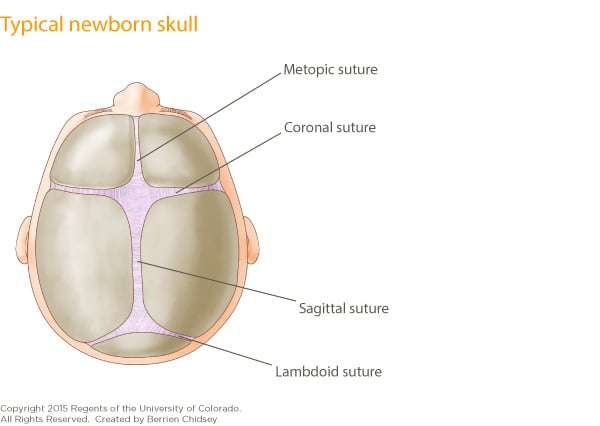
However, when a baby has craniosynostosis, it means that one or more of the sutures closes earlier than expected. When this happens, skull growth at the closed suture slows down or stops, but the brain keeps growing, which causes an increase in growth in the areas where the sutures are open. This leads to an atypical head shape. In some children, craniosynostosis can affect brain growth and development.
Types of craniosynostosis
Each type of craniosynostosis has its own characteristics. Each type gets its name from the name of the closed suture.
Below are types of craniosynostosis that we frequently see at the Craniofacial Center at Children's Hospital Colorado. The name of the closed suture is represented in each type (the corresponding head shape is in parentheses).

Metopic craniosynostosis (trigonocephaly)
- Triangular forehead with the eyes close together
- Ridge running up and down the middle of the forehead
- More common in boys than girls
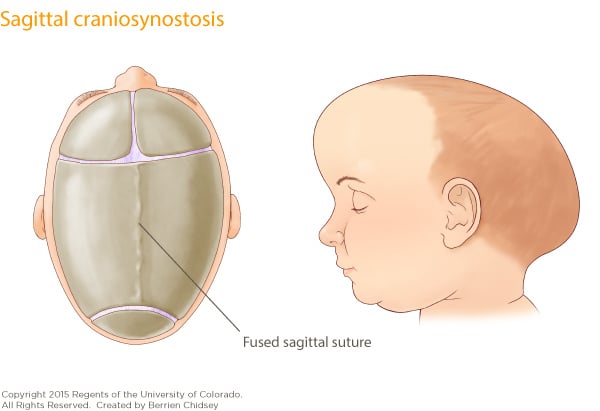
Sagittal craniosynostosis (scaphocephaly)
- Long and narrow head
- Prominent forehead and occiput (back of head)
- Ridge running from front to back along the top of the head
- Most common type of craniosynostosis
- More common in boys than girls
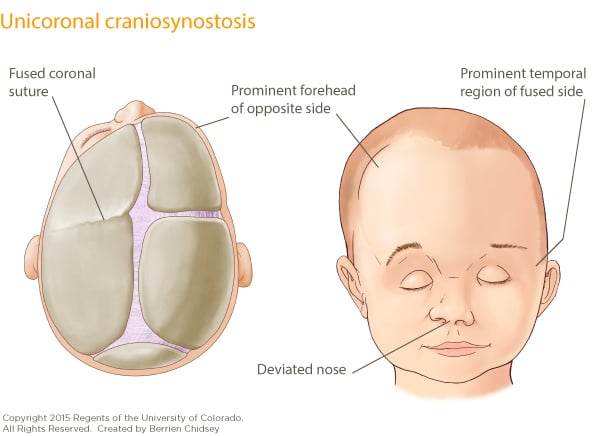
Unicoronal craniosynostosis (anterior plagiocephaly)
- One eye appears more narrow, while the other eye appears wider
- One side of the forehead appears more prominent, while the other is flattened
- Mild curvature to nose
- Ridge running from the top of the head down one side toward the ear
- More common in girls than boys
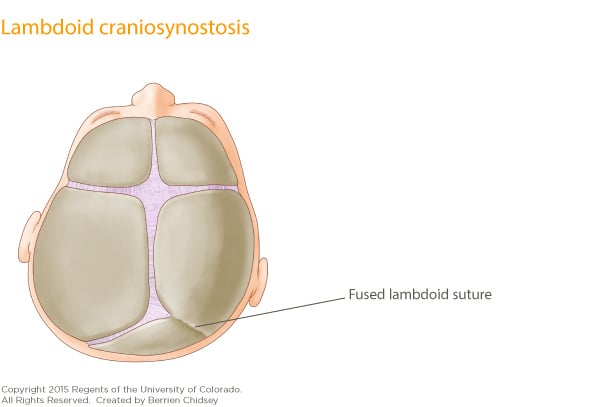
Unilateral lambdoid craniosynostosis (posterior plagiocephaly)
- Flat occiput (back of head) on one side
- One ear may be further back and down than the other ear
- Least common type of craniosynostosis that involves only one suture and is not caused by a known syndrome
What causes craniosynostosis?
Craniosynostosis occurs in babies with and without a family history of the condition. Sometimes, it occurs as part of a syndrome or genetic disorder. There are over 150 genetic syndromes that are known to cause craniosynostosis.
When craniosynostosis is not part of a syndrome (non-syndromic craniosynostosis), it is usually not inherited, which means that it is not passed from a parent to a child. Most cases of craniosynostosis are non-syndromic.
A geneticist at Children's Colorado can help your family understand the cause and future risks related to a diagnosis of craniosynostosis.
Who gets craniosynostosis?
Craniosynostosis occurs in about 1 out of every 2,500 newborn babies. There is a 0-4% chance that a sibling born after a child with craniosynostosis will also have the condition. A similar risk exists for children of parents with craniosynostosis.
What are the symptoms of craniosynostosis?
In most cases, craniosynostosis does not cause any symptoms in babies. However, you or your pediatrician may start to notice physical signs of craniosynostosis as soon as your baby is born or a few months later.
Signs of craniosynostosis may include:
- Atypical head shape
- Asymmetric facial features
- Early closure of soft spot
- Ridge on the skull where a suture is fused
A difference in head shape doesn't always mean that your child has craniosynostosis. Your child may have a condition called deformational plagiocephaly, which is related to his or her sleeping position. Or, your child may simply have a normal variation in head shape. Early closure of his or her soft spot or a ridge on the skull also doesn't always mean that your child has craniosynostosis. In some children, the soft spot just closes early and in others the skull just has a ridge or two.
As some kids with craniosynostosis get older, they may take longer to reach milestones in their intellectual and physical development. Sometimes, a child can have problems with eye movements, and, rarely, with vision itself.
What tests are used to diagnose craniosynostosis?
At Children's Colorado, your child's visit to the Craniofacial Center includes a:
- Medical history
- Physical evaluation
Pediatric specialists may need additional tests to confirm the diagnosis and aid in treatment planning. Additional tests may include
- Computed Tomography (CT scan) enables doctors to see detailed views of the sutures of the skull.
- Magnetic Resonance Imaging (MRI) forms a clear view of the brain.
- Genetic testing allows specialists to check for related syndromes.
- "3D" photography helps specialists make various measurements of your child's head.
Why choose the Craniofacial Center at Children's Colorado for your child's test?
At Children's Colorado, our policy is to image gently. That means our state-of-the-art diagnostic equipment uses the lowest level of radiation possible to obtain clear and accurate images to aid in the diagnosis and treatment of your child. Not only is our equipment made for kids, but our pediatric specialists help kids relax and feel safe during testing.
How do specialists at the Craniofacial Center make a diagnosis?
Specialists in the Craniofacial Center collect all the information from the medical history, physical exam and any imaging that was requested. Together, doctors in the multi-disciplinary team work together to give your family an accurate diagnosis and formulate a treatment plan.
They take into account:
- Your child's age, health and medical history
- Craniosynostosis type (which suture or sutures are involved)
- How atypical the head shape is
- Your input and preferences
How is craniosynostosis treated?
Your child's treatment may include:
- Monitoring by surgeons who specialize in caring for children with craniofacial conditions in our Craniofacial Center
- Surgery
- Wearing a helmet
- Physical, speech or occupational therapy if necessary
Craniosynostosis surgery
Surgery is often the recommended craniosynostosis treatment. The goals of surgery include:
- Producing a more typical head shape
- Providing room for the brain to grow and develop
Before craniosynostosis surgery
Talk with our pediatric anesthesiologists
Anesthesia is a combination of medications that puts children in a sleep-like state. Since anesthesia affects children differently than adults, our anesthesiologists are pediatric trained and experienced to keep kids safe during and after surgery. Before craniosynostosis surgery, parents talk with a pediatric anesthesiologist.
Take a presurgery tour or watch a presurgery video
Preparing for surgery is important for your family's mental and emotional health. Children's Colorado offers families the opportunity to tour the hospital and ask questions about the day of surgery and recovery after surgery. Your family can also watch a presurgery video that explains everything you can expect to happen on the day of surgery. Both the tour and the video help ease anxiety and tell you what you can expect at Children's Colorado.
About minimally-invasive endoscopic craniosynostosis surgery
Your child's surgeon may recommend minimally-invasive endoscopic surgery when your baby is between two and four months of age and has only one closed suture. The recommended age depends on the type of craniosynostosis your baby has. Endoscopic surgery may not work as well in older babies or when more than one suture has closed early.
What happens during minimally-invasive endoscopic craniosynostosis surgery?
Surgeons perform minimally-invasive surgery through small incisions just big enough to fit surgical instruments through. To see inside your child's head, surgeons use a small camera while performing surgery.
- Before surgery, your child is put under general anesthesia, which means they are in a sleep-like state.
- The surgeons create one or two small incisions (cuts) in the scalp. Then, a thin tube with an attached video camera and other instruments are inserted through the incision(s). The camera lets the surgeons see inside your child’s head while they perform surgery.
- Once the camera and the instruments are inserted, the surgeons remove a narrow strip of bone along the closed suture, which opens the suture. Sometimes, extra cuts are made in the skull without removing any bone; this helps reshape the skull.
- Finally, the surgeons remove the instruments and close the scalp incisions with dissolvable stiches.
- Infants usually stay in the hospital between one and three days after surgery.
- After surgery, your baby may need to wear a special helmet to help mold the shape of their head. This helmet may be worn anywhere from a few months or up to a year or more.
About traditional open craniosynostosis surgery
Open surgery is the traditional surgical method for treating craniosynostosis. Surgeons may recommend open surgery if your baby is older than four to six months of age or has more than one closed suture.
The timing of open surgery depends on the type of craniosynostosis your baby has. Typically, surgeons recommend that babies with sagittal craniosynostosis have open surgery between three and 12 months of age. Babies with coronal or metopic craniosynostosis have surgery between four and nine months of age. However, surgeons may perform open surgery even when your baby is over one year of age.
What happens during open craniosynostosis surgery?
- Before surgery, your child is put under general anesthesia, which means they are in a sleep-like state.
- First, the surgeons create a wavy incision (cut) in the scalp. The position of the incision depends on what parts of the skull the surgeons need to work on.
- Once the skull is exposed, the surgeons may remove a strip of bone along the closed suture, which opens the suture. When this is done, extra cuts may be made in the skull without removing any bone; this helps reshape the skull. Or, surgeons may not remove a strip of bone at all. They may instead make many cuts in the skull and extensively remodel it.
- Finally, the surgeons close the incision with dissolvable stitches.
- After open surgery, infants usually stay in the hospital between two and four days.
- Infants who undergo open surgery usually don't wear a helmet afterward to help reshape the skull. However, older babies who are starting to walk usually wear a protective helmet for several weeks until the remodeled skull bone is strong enough that the helmet isn’t needed.
Recovery from craniosynostosis surgery
After most children leave the hospital, they only need over-the-counter pain medicine, and only for several days. Dissolvable stitches usually start to break down on their own within two to four weeks. By that time, surgical scars will be pretty strong, although they will continue to remodel over the next one to two years. Your baby child may take several days or weeks to return to normal sleeping behavior.
You and your baby will return to the Craniofacial Center several times the first year after surgery for checkups, then usually once a year for the next several years. "3D" photography is used during many of these appointments to help doctors keep track of the growth of your child’s head.
As a parent, you may be nervous about your child's head once the bone is removed. The team in the Craniofacial Center will answer any questions you may have about caring for your child.
Why choose the Craniofacial Center at Children's Hospital Colorado?
A leading craniofacial program in the region
Our Craniofacial Center is one of the most experienced programs in the nation. With over 25 years of experience, we are the leading center in the Rocky Mountain Region for craniosynostosis treatment. Our program is the only program in Colorado to be approved by the American Cleft Palate-Craniofacial Association (ACPA).
Access to pediatric experts from multiple specialties
Patients and families who visit the Craniofacial Center have access to multiple pediatric specialties that all collaborate to treat the whole child. Pediatric specialists who care for patients in the Craniofacial Center include the following:
- Pediatric craniofacial plastic surgeon
- Pediatric neurosurgeon
- Pediatric advanced practice nurse
- Pediatric nurse practitioner
- Pediatric otolaryngologist (ear, nose and throat doctor)
- Pediatric geneticist
- Pediatric ophthalmologist (eye doctor)
- Pediatric orthodontist
- Pediatric dentist
- Pediatric anesthesiologist
- Pediatric social worker
- Pediatric physical and occupational therapist
- Pediatric speech pathologist
- Pediatric audiologist
- Pediatric neuropsychologist
Next steps
-
Would you like to learn more about us?
Learn more about the Craniofacial Center -
Do you have questions about your child’s condition?
720-777-5578

Compassionate care, wherever you are
We’re here when you need us. Telehealth appointments are available across every specialty, so you can get the high-quality care we’ve always offered from the comfort, privacy and convenience of home.
See if telehealth is right for you
Get to know our pediatric experts.
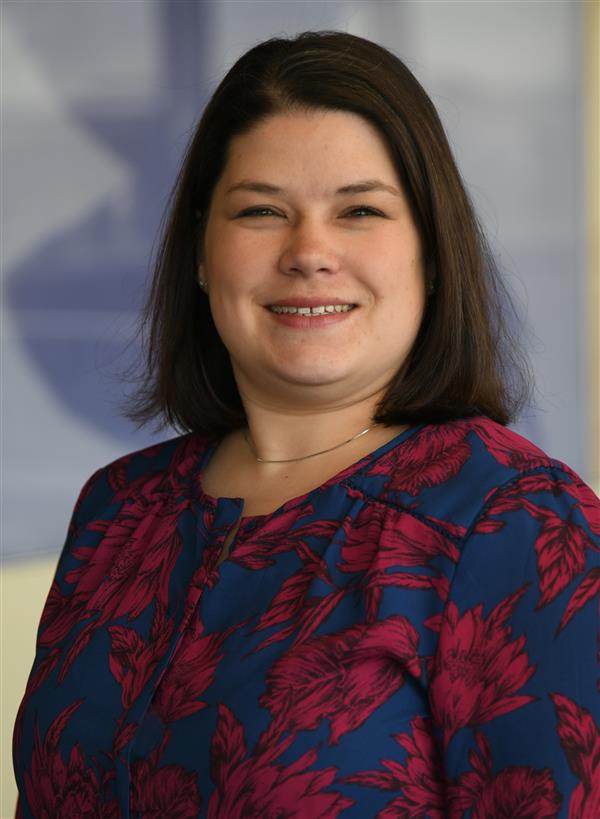
Becky Hill, CPNP-AC/PC
Certified Pediatric Nurse Practitioner, Certified Pediatric Nurse Practitioner
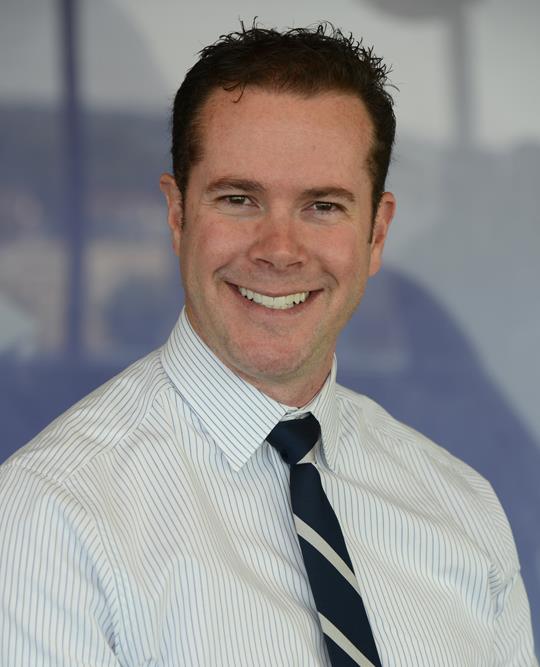
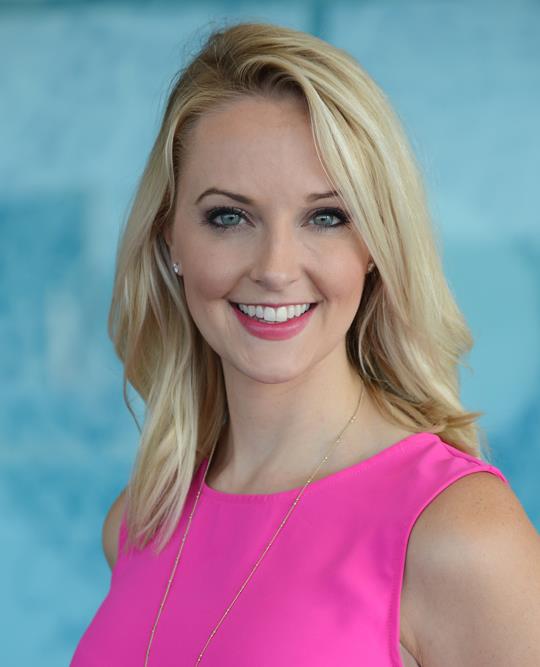
Stephanie Fingland, CPNP-AC/PC
Certified Pediatric Nurse Practitioner, Certified Pediatric Nurse Practitioner



 720-777-0123
720-777-0123








